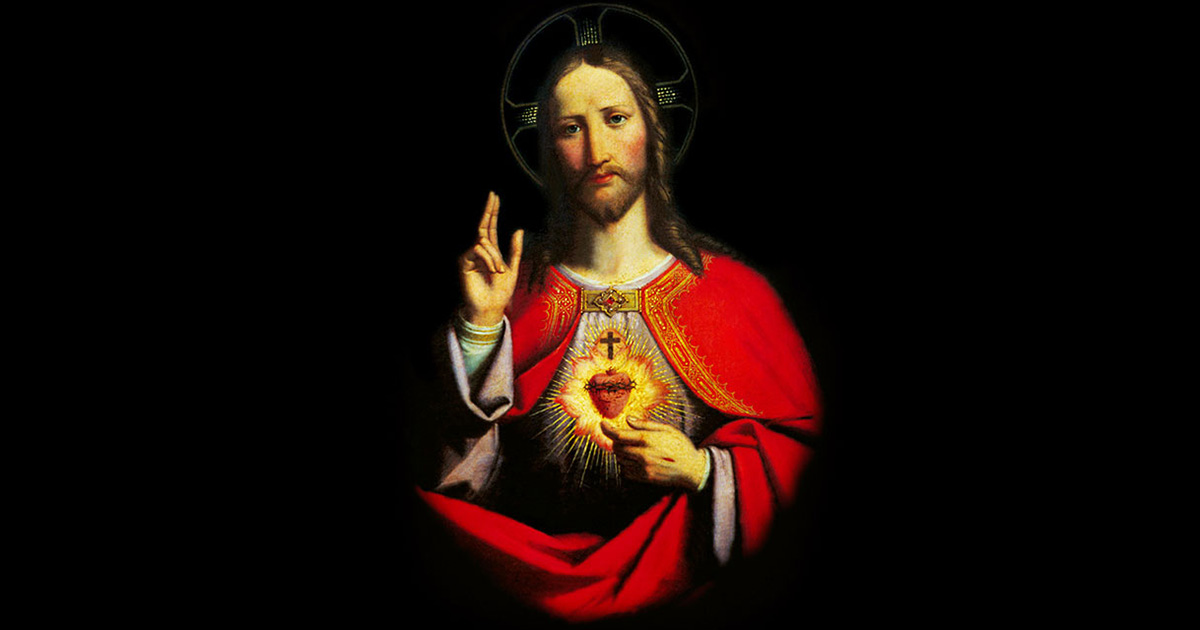Devotion to the Sacred Heart teaches us that the way of the saints is not about an abstract ideal or rules for life, but about the unfathomable love of God, who we embrace—blood, sweat and all.
The objection I often feel when I see a picture honoring the Sacred Heart of Jesus is that it’s just too real. Confronted with vivid colors, visible veins, striated muscles, I am suddenly uncertain. Do I really want a savior who has taken on human flesh?
Many days, I don’t. I get caught up in my head, subtracting Christ from the picture, making the Scriptures and the sacraments optional additions to my project of “being a good Catholic.” I try to live out my faith with calculating purpose, the same way that I plow through my taxes or reconcile my bank statements, hoping that, in the end, the numbers will show that I am “in the black.”
Over time, living this way has become increasingly difficult. When I fail to follow the rules, I feel bad, guilty. When I do keep on track, I pat myself on the back and congratulate myself for a job well done: What a good girl I am! But the happiness is short-lived. Tomorrow comes, and the drama of “trying to be good” must begin all over again. I eke along, vacillating between pride and despair – never certain of my place, never at home. How perilous this road! And how different, I now understand, than the path taken by the saints.
The way of the saint is not one of calculating and formulating, but of seeking and finding, of following and remaining. The saint is someone who seeks to be seen, to be known, and to be loved. And he has found the answer to this longing in the relationship with a Someone, a divine person who eats breakfast, cries for his friends, sweats when He’s afraid, and bleeds when He’s pierced. In the approachable humanity of Jesus Christ, he has met the unfathomable love of God. And the saint runs forward and embraces him — blood and sweat and all.
St. Elizabeth Ann Seton lived this encounter with God-in-the-flesh as the heart of the drama that was her conversion to the Catholic faith. By birth a blue-blooded Episcopalian, Elizabeth was no stranger to high-minded morality. Yet she longed for more, craved a contact with God that was daily and tangible. First attracted to the Catholic faith while staying with the Filicchi family in Italy, she discovered in the rhythms of fasting, prayer, and daily Mass the answer to her ache for the intimacy of God’s presence. When Antonio Filicchi showed Elizabeth how to mark herself with the sign of the cross, she marveled at the profound meaning of this physical gesture:
“The sign of the CROSS on me—deepest thoughts came with it—of I know not what earnest desires to be closely united with him who died on it.”
When she returned to New York from Italy, still very much attached to the community of her upbringing, but eager to enter the Church, Elizabeth contrasted the spiritually vague appeals of her Episcopalian friends with the concreteness offered by an image of the Crucifixion:
“They tell me I must worship him now in spirit and truth, but my poor spirit very often goes to sleep or roves around like an idler for want of something to fix its attention, and for the truth… I think I feel more true Union of heart and soul with him over a picture of the Crucifixion.”
Elizabeth drew close to Christ, “begging our Lord to wrap my heart deep in that opened side so well described in the beautiful Crucifixion, or lock it up in his little tabernacle where I shall now rest forever.” And when she at last came into the Church, her first Communion—the very act of partaking in the flesh and blood of Jesus Christ—was a moment of unsurpassed joy. As she wrote to Amabilia Filicchi, “At last GOD IS MINE AND I AM HIS!”
St. Elizabeth Ann was not convinced by an ideal, a standard, or a set of rules for life. She was attracted to a flesh-and-blood person who had died on a real cross and gave his body and blood for real food and drink. When she found this man, she handed her whole self over to Him. And this relationship was what gave Elizabeth the energy for every other thing she ever achieved as a mother, a foundress, and a saint.
Strength, endurance, certitude, joy — all these were features of Mother Seton’s spiritual life that I long to share! As I read her writings, it’s clear to me that the only way forward is this personal union with Christ, possible in and through his body the Church, and all that She offers – the sacramental life, the rhythms of feast and fast, and the companionship that is the communion of saints.
If I try to live my life by conforming to a measure, no matter how exalted, I’m exhausted and uncertain. But if I instead set my eyes on the Crucified One, seeking to follow him and to abide with him and to “wrap my heart in that opened side,” – then I can truly live each day in joyful hope.
LISA LICKONA, STL, is Assistant Professor of Systematic Theology at Saint Bernard’s School of Theology and Ministry in Rochester, New York, and a nationally-known speaker and writer. She is the mother of eight children.
Source: https://setonshrine.org/








0 Comments